Art Print White House With Blue Roof and Stone Bridge
Monet's 'other' masterpiece: His gardens at Giverny
Anna Hartley: It seems appropriate that to get to Claude Monet'south home at Giverny, I'm leaving Paris from the Saint-Lazare train station

Reviews and recommendations are unbiased and products are independently selected. Postmedia may earn an affiliate commission from purchases made through links on this page.
It seems appropriate that to get to Claude Monet's home at Giverny, I'm leaving Paris from the Saint-Lazare train station. In a famous series of paintings, the impressionist master captured the busy energy of this station, an in-between space of hurried, blurred figures, with clouds of steam from budgeted locomotives billowing under its iron-and-glass arched roofs.
But it was his outdoor paintings that Monet is best known for, including those of his gardens in Giverny, about 64 kilometres northwest of Paris.
Monet moved to Giverny in 1883, centre-anile and nearly penniless. 9 years earlier, he had exhibited "Impression: Sunrise," the painting attributed with giving the impressionist movement its name. However true artistic success and financial stability would be years away. During the 43 years that Monet lived in Giverny, he came to be regarded as one of the world'south greatest artists, attaining international fame and a considerable personal fortune, much of which he funneled into his other passion, horticulture.
He spent years designing and landscaping the property he acquired here, working – with the aid of his team of gardeners and small children – with the specific intention of creating spaces that he could paint. The gardens he created have come up to be called his "other" masterpiece.

Merely 45 minutes later on leaving Paris, my train pulls into the town of Vernon, just inside the region of Normandy. Giverny lies a few kilometres away, but with a population hovering effectually 500, it's non on the main line. From here, I'll take to make my own manner.
Walking out of the station, I bypass the little motorized train and the air-conditioned shuttle bus, either of which would have me the vi kilometres to Giverny. Instead, for the equivalent of almost $15, I rent an onetime ten-speed bicycle for the 24-hour interval from the cafe directly opposite. It's perfect. The waitress/bike-renter offers me a home-made map highlighting an piece of cake bicycle path to my destination. She pumps air in the tires and comments on the perfect conditions. The sun is rise quickly, the heat first to prickle the skin on the back of my neck.
When exercise I need to bring the bike dorsum?
"Take your time!" she waves me off cheerily and turns to serve another customer.
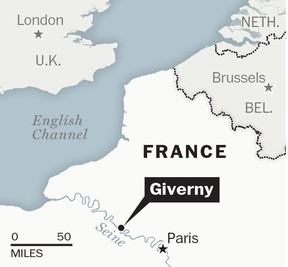
It's mid-August, then Vernon, like villages all over French republic, is quiet, with bakeries, pharmacies and hairdressers alike displaying hand-scrawled signs proverb "Airtight for summer." I cruise down the well-nigh empty master street toward the river, detouring past the leering gargoyles of the church Notre-Dame de Vernon.
Crossing the Clemenceau Bridge, I take stock of the drowsy Seine – hard to recognize as the same river that flows through Paris. The banks here are natural, with grass and trees growing downwardly to the h2o, and a cacophony of swans, geese and ducks gathering in the dingy shallows beside a battered 16th-century factory. Hither begins the André Toufler path, an quondam train line converted into a bike-friendly path. On my left, grapevines scramble amongst yellow dandelion flowers, and copse covered with creepers create a dense, green curtain that climbs up the hillside. On my right, I see into well-tended back yards abreast nifty houses. I ride through a deject of sweetness rose perfume. Across the houses, the land opens up to cornfields, pastures of sturdy grazing Maine-Anjou cows, and the steep roofs of houses, as white as the chalk in the hills beside me.
I'thousand a chip sad to see the path end at the main route, Rue Claude Monet. This must exist Giverny. As I ride up a slight hill, the prevailing theme in town appears to be flowers: Every single garden is abundantly, gorgeously cultivated in a kind of anticipatory tribute to the famous property beyond. Do people move here because they love to garden? I wonder. Or is it the effect of some boondocks decree?
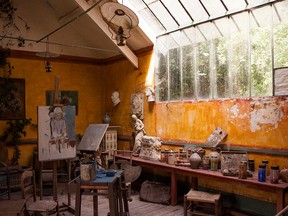
One concluding ascension, and I'm greeted with a friendly sight: the warm, rose-pink facade of the Ancien Hôtel Baudy, the restaurant where I've planned to have luncheon. The large terrace is already starting to fill up with the midday oversupply. Old, coppiced plane trees create a thick greenish roof over faded blood-red umbrellas and pastel metallic tables.
In its heyday, from the belatedly 1880s until the beginning of the Neat State of war, the Hôtel Baudy was the center of the village's thriving social scene. Originally a tiny bottle and general shop, information technology expanded thanks to the sudden influx of American and international artists. Attracted to the region for the cute landscapes, the cheap rent and the tantalizing proximity of Monet himself, they came by train from Paris, sometimes intending to stay for a few days and leaving years later.
The American artist William Metcalf is attributed with "discovering" Giverny in 1886, and the likes of John Singer Sargent, Paul Cézanne, Theodore Robinson, and Mary and Frederick MacMonnies are among the better-known painters who patronized the Baudy. Of form, not all of the artists who stayed there plant fame and fortune, and some original artworks, traded in lieu of room payment, still hang behind the wooden bar.
I lock up my cycle side by side to a large patch of lawn that was once a tennis court and arroyo the terrace.
"1 for lunch, delight." A glass of rosé arrives speedily, closely followed past fifty'assiete du soleil, a huge plate of roasted summer vegetables, parmesan and cured ham. The audio of gravel crunching underfoot equally waitresses flit between the tables mingles with the bright chatter of the polyglot lunch crowd.
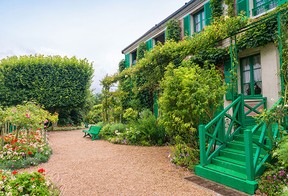
Afterwards, I wander effectually the eatery'south back garden, poking about the sunny atelier, which was built in 1887 to accommodate the many artists-inresidence. Dust specks drift in the air, and the cobwebs are thick. Pots and brushes lie nigh, and an unfinished painting rests on an easel. It feels like the last artist simply put downwards his brush and walked away.
As I had feared, a long line of visitors are waiting to enter Monet's home, snaking a few hundred yards up the road, so I turn instead to the many fine art galleries that pepper the main street.
At that place seems to be something for everyone here, from surprising modern street-art-inspired canvases to cloying pastoral scenes.
Mod-looking Espace 87 catches my center, and, wandering in, I chat with the personable gallery director and sculptor Alain Brieu. I remark upon the high number of galleries for such a small town. Brieu points out that the town naturally attracts art lovers; even if simply a fraction of the one-half a 1000000 or then that arrive every year actually buy something, it is enough for many businesses to flourish.
"Are there any impressionist artists here now?" I ask.
"Impressionist painters don't exist anymore, there are only imitators," he declares, in a way I've come up to see every bit distinctly French. There are certainly plenty of those around. Brieu shrugs. "Nobody tin afford to buy real impressionist art now."
Well, not in the medium the artist originally intended. But Monet's works are emblazoned on everything from umbrellas to mugs to tea towels on auction in the gift shops. "Information technology'due south dreadful! Truly dreadful!" Brieu says. "The just things that aren't dreadful are the prints, only why not buy an original piece of art instead?" With a smile, he gestures to those hanging on his walls.
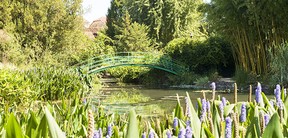
I arrive at Monet'due south house just after 4 p.m. Every bit I enter the famous gardens, I have a deep breath and brace myself for a seething mass of tourists. Merely to my surprise, information technology is calm. People wander here and there amidst the flowers or rest on benches.
Flowers of every colour fill up my field of view, seeming to crowd in, nodding slightly in the breeze. It looks similar a paint factory has exploded. Divided into rows, dominated by a broad central path leading to the front end door of his habitation, the garden called Clos Normand is structured quite traditionally, still it feels overgrown in a pleasing, messy, impressionist kind of way.
As I accept a few photographs, information technology strikes me how hard it is to observe perspective here. The density of plant life in all of its colours makes judging distances difficult, and I'grand surprised to run across a small girl walk by me, but most 2 feet away, on a parallel path utterly subconscious from my view. Bees buzz. Children pose for their parents in the warm sunshine.
Then I come to the road.
Rumbling with trucks and local traffic, it literally cuts Monet'due south gardens in half. Visitors are protected by an underpass, and high walls hide it from view. Merely as I approach the bottom of the garden it's impossible to miss, and I'm surprised that it has never been diverted.
Emerging moments afterward the other side, I find the landscape radically changed. A lush oasis of clear pools, huge ferns and a woods of tall green bamboo as thick as my wrist constitute Monet'southward famous Water Garden.
Branches of huge weeping willows brush the surface of the even so h2o, creating ripples. A brilliant blueish dragonfly perches beside a shaded stream, then still I recall information technology might be asleep. The famous arching green bridge is held tight with densely winding purple wisteria. The bailiwick of countless paintings and photographs, it is now crowded with picture takers: In their bright summer dress, from a distance, they await a bit like flowers themselves.
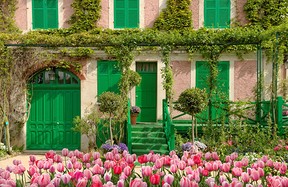
It'southward calm here, and I sit on one of the many benches. An elderly couple walks by, quietly discussing the lilies in knowledgeable terms.
A big red truck goes by, the peak of its cabin visible over the garden wall.
Eventually I brand my fashion upwards to the house itself. Rose-pink with dark-green shutters on the exterior, and vibrantly painted inside, information technology is undoubtedly an artist'due south home. Each room seems to have its own character, and strong, well-balanced colours give it a strangely modern feeling. Most surprising of all are hundreds of original Japanese woods cake prints that were in Monet'southward private collection. I recognize the proper noun Hokusai, and I do a double-take to come across a impress of his unmistakable "The Great Moving ridge off Kanagawa" hanging on the wall.
Leaving the home through its sunny dining room and adjoining china-blue kitchen, I wait at my scout and become a shock; I've got exactly 33 minutes before my train departs. Exiting through the enormous gift shop, really the studio in which Monet painted his famous "Water Lilies" series for the Orangerie Museum in Paris, I become on my bike and ride.
Zooming downward Rue Claude Monet, past the galleries, past the Impressionist Museum, by the Hôtel Baudy, I pause briefly at the church of Sainte-Radegonde de Giverny to pay my respects at Monet's grave.
Half a lifetime away from the man who trailed into Giverny poor and with an uncertain hereafter, the successful and prosperous artist succumbed to lung cancer at the historic period of 86. Rejecting the pomp of a state funeral, he was buried in this local graveyard with just family and close friends in attendance. Right at the end of the ceremony, in a moment that reads as if from a play, Monet's longtime friend Georges Clemenceau, the former French prime minister, ripped off the blackness cloth that draped his coffin, declaring: "No! No black for Monet! Blackness is not a colour!"
Today, the extended Monet family plot is covered in flowers.
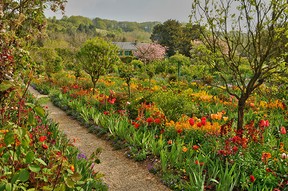
IF You lot Become
Where to stay:
Les Rouges Gorges: vi Rue Aux Juifs; 011-33-232-51-02-96, lesrougesgorges.com.
A village inside a hamlet. Cute timber and stone cottages placed around a paved courtyard overgrown with flowers and greenery make this a welcome B&B stay in the medieval centre of Giverny. Rooms from about $60.
Les Arceaux: 49 Rue Claude Monet; 011-33-232-21-61-17, giverny.fr.
A spacious and stylish two-story home with a big garden, terrace and patio. A couple of minutes' walk from the Claude Monet Museum. Rooms from about $140.
Where to eat:
Fifty'Ancien Hôtel Baudy: 81 Rue Claude Monet; 011-33-232-21-x-03, restaurantbaudy.com.
The canteen-turned-hotel that housed famous French and American artists in Giverny'due south heyday. Take lunch under the dappled shade of the terrace. Entrees start at about $18.
Le Petit Giverny: 41 Chemin du Roy; 011-33-232-51-05-07, lepetitgiverny.com.
Hidden a street away from the relatively busy Rue Claude Monet, this brasserie-grill serves up tasty steaks and fresh regional produce. Entrees start at near $sixteen.
What to do:
Fondation Claude Monet: 84 Rue Claude Monet; 011-33-232-51-28-21, fondation-monet.com.
Visit the home where impressionist painter Claude Monet spent one-half of his life and the gardens that inspired some of his masterpieces. Open daily from March 28-Nov. one, 9:30 a.m. until 6 p.m. Last access 5:30 p.thousand. $10, children ages vii to 17 and students about $half dozen, younger gratis.
Information:
giverny.org
Source: https://nationalpost.com/travel/monets-other-masterpiece-his-gardens-at-giverny

0 Response to "Art Print White House With Blue Roof and Stone Bridge"
Post a Comment